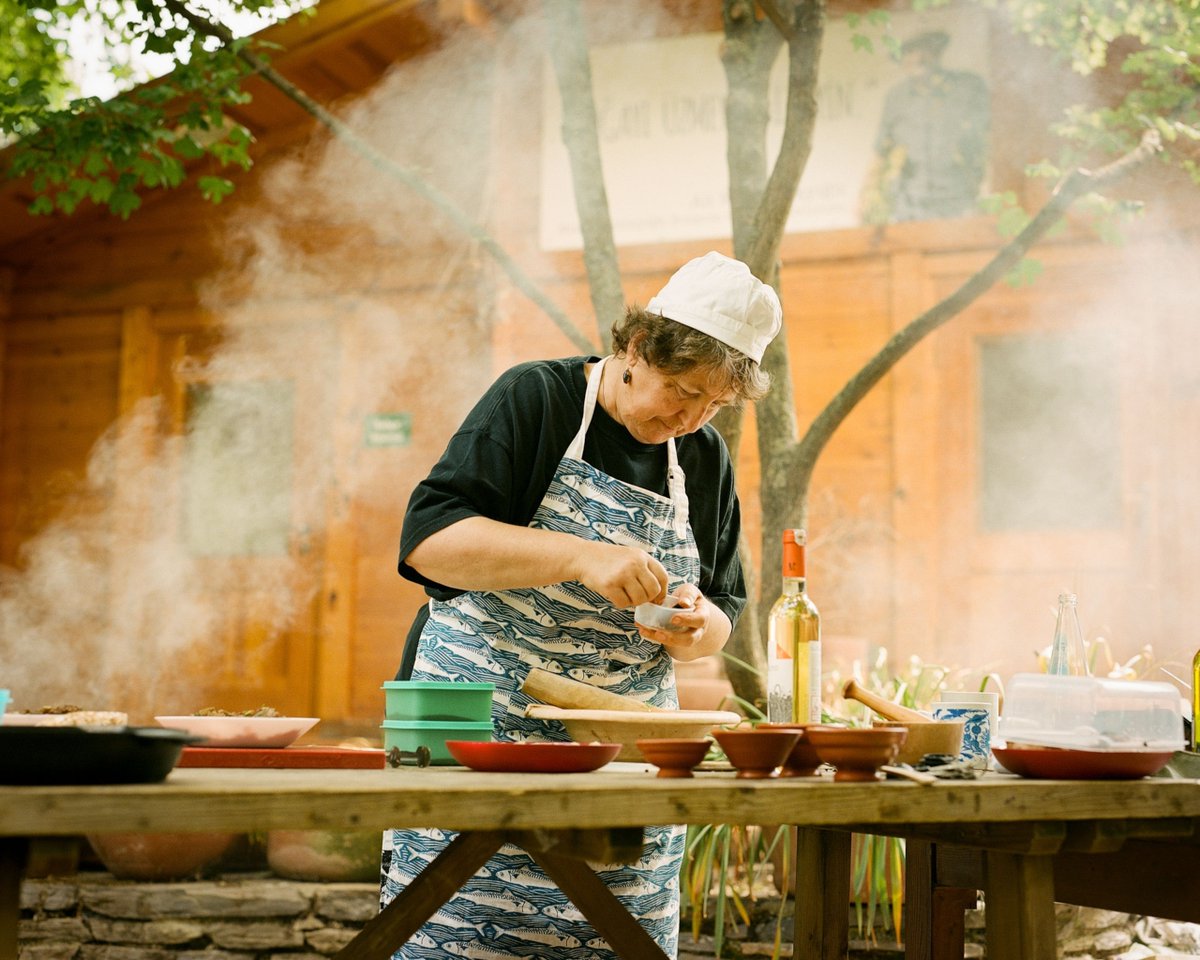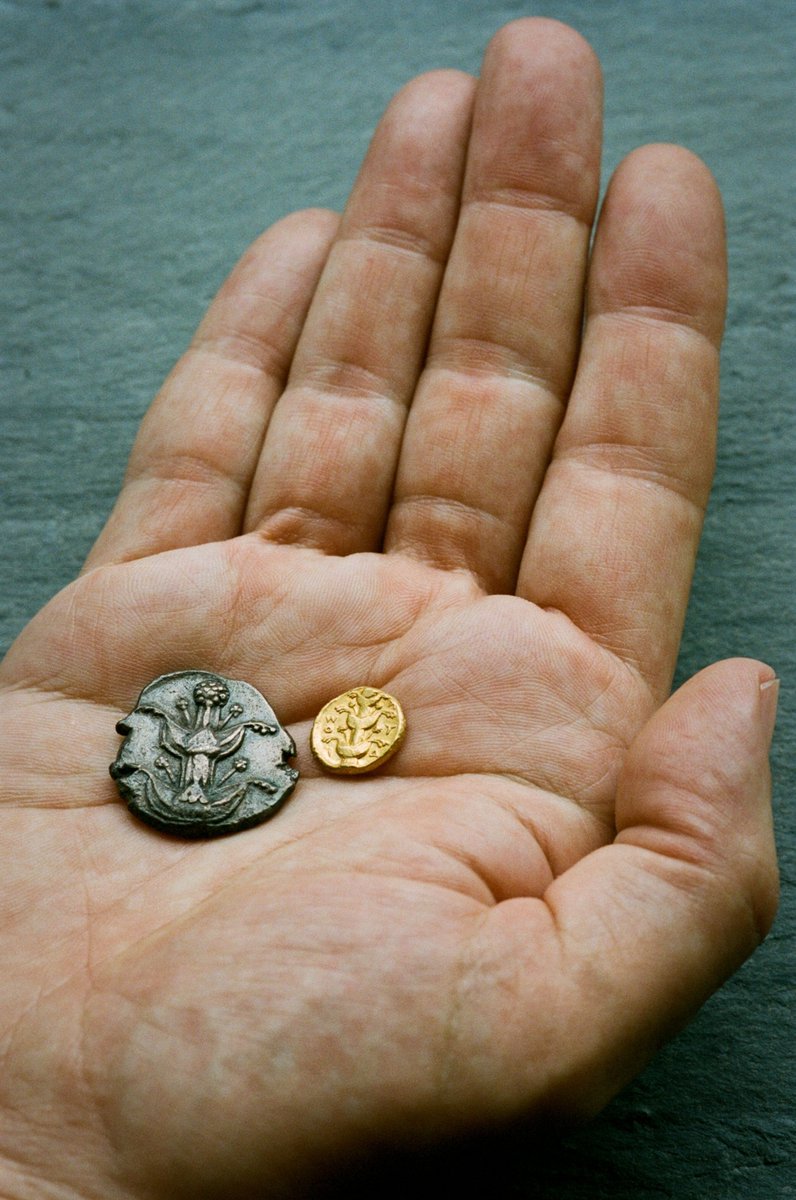
We succeeded in recreating a Neolithic flatbread!
This is about as close as I can figure out how to make bread as it would have been baked in one of the first daily bread-making cultures, ca. 9,000 years ago. I’ll let you judge the authenticity…but the taste is fantastic.
This is about as close as I can figure out how to make bread as it would have been baked in one of the first daily bread-making cultures, ca. 9,000 years ago. I’ll let you judge the authenticity…but the taste is fantastic.
Bread thread 🍞🧵 follows...
I should start from the beginning. A year ago, I went to the Çatalhöyük site in central #Turkey. A proto-urban Neolithic community, pop. as high as 8,000, inhabited for 1000+ years starting ca 7200 BCE. 



In the excavations, I saw the placement of the beehive-shaped ovens and the storage bins that almost every dwelling had. Helpfully, replica houses showed exactly what these looked like. 



Lacking though was the means of grinding the bread. This was a saddle quern, which consists of a slab of andesite and a (usually) oval-shaped grindstone. This I found in the Museum of Anatolian Civilizations in #Ankara. 

For months I tried to find an equivalent, checking with museums all over. Finally I reached out to an archaeobotanist at the British Museum who'd done her own Neolithic bread-baking experiments. She said the closest equivalent was a Mexican metate—she used one with good results.
I tried to source one through Mexican chefs in #Montreal, to no avail. So I ordered one with Etsy. (Yeah, I know.) It arrived from Oaxaca, 22 x 30 cm, on three legs, made of basalt. 

The next step was to find the ancient grain used by Çatalhöyükans. This is emmer, which they probably first gathered in the wild, but then grew near the settlement. Latin name Triticum turgidum subsp. dicoccum. Italians call it farro—which I found at a grocery store near my home. 

I'm going to have to sign off for today...got to make my kids dinner! But this will be continued. (Making it a Cereal Serial, I guess.) Tune in tomorrow for more...
The Neolithic bread thread continues...
I wasn't completely sure about the emmer from Italy (sometimes it's another "ancient" grain, spelt), so I ordered some from an organic supplier in British Columbia, Canada.
I wasn't completely sure about the emmer from Italy (sometimes it's another "ancient" grain, spelt), so I ordered some from an organic supplier in British Columbia, Canada.

Emmer is a beautiful grain! Very hard, silky and glistening between the fingers. Each grain is about the size of a…mouse turd. (A non-beautiful analogy, it’s true.) 

I’ve been making sourdough for the last six or seven years, but I’ve never ground my own grain. So I took my emmer and my metate to Marc-André Cye, #Montreal’s knowledgable “Baker on the Go” (His handle on Instagram). Here we are at his HQ! 

Marc-André was really intrigued by the project. He’s ground grain mechanically before, but never on a quern. 



Here are the first passes with the grindstone (or “mano”) on the metate. It is clearly designed to roll over corn (maize) rather than wheat.
The pores in the basalt were huge, but they quickly filled with flour, providing a smoother surface. Marc found tiny flecks of stone in the first batches of flour, so we threw those out. Ancient Egyptian teeth were worn down by microabrasions, probably for this reason 

Marc had taught me the technique, so at home I got to work grinding enough emmer to make the flatbread. I found 4 tsps, about 20 grams, was a good amount to do per batch. Each batch could take up to 7 minutes to grind into flour.
The technique is pretty intuitive—back and forth grinding. (Almost like the quern was a set of molars, part of the pre-digestion process.) But it's physically demanding. It worked better when I put it on the floor, kneeled, and put my full weight into the mano-grindstone. 



I averaged about 120 grams per hour. My back was sore for days; the spasms in my upper arms have just stopped; I got blisters on my palms! Making bread was time-consuming and exhausting—people must have really wanted it. 

It took me four hours, in two sessions, to grind enough for a “daily bread” make. The flour smelled great, by the way, woody, complex, nutty.
Grinding grain seems to have been a gendered activity in Egypt; wear-and-tear on skeletons suggests it fell disproportionately on women. Not in egalitarian Çatalhöyük, where evidence suggests men and women might have shared in grinding tasks.
journals.ed.ac.uk/lithicstudies/…
journals.ed.ac.uk/lithicstudies/…

According to archaeobotanists (hey Lara and Amaia!) who have excavated at Çatalhöyük, bread there was unleavened. That is, no sourdough starter. The dough may have been left out for several hours to collect natural yeasts from the environment. I mixed the flour with water... 

I didn't use any oil. However, I did add a few grams of salt. This is controversial, as no salt storage has been found at Çatalhöyük. But absence of evidence is not evidence of absence (and there are many saltflats in the area), so I erred on the side of flavor. 

What archaeologists did find in abundance at Çatal was wild mustard grains. Descurainia sophia is known in Persian cuisine as Khak-shir. I tracked some down at an Iranian supermarket. Like mustard without the harsh bite, and quite refreshing. 



A handful of Khak-shir went into the mix. Overnight, the dough swelled slightly, remained wet and sticky.
Now I had to figure out how to bake it. I considered making my own Neolithic firin (wood oven) out of clay, which is what one archaeobotanist did...
Now I had to figure out how to bake it. I considered making my own Neolithic firin (wood oven) out of clay, which is what one archaeobotanist did...

Instead I decided to turn to an expert for help. I took my emmer dough (including a control batch made with bread wheat, T. aestivum) to Bika, a farm-to-table Turkish restaurant outside #Montreal. 

I was welcomed by chef Fisun Ercan and her husband Tulga. Fisun grew up in a village near Izmir, where her family baked flatbreads regularly. 

She also has a large version of a firin, with clay walls. It’s like a big, communal version of the dome-shaped ovens you’d find in Çatal. At 730 that morning she started a fire using logs from ash trees. 

Fisun rolled out the dough and cut it into pita-sized breads, the way she used to in her village in Turkey. We made a control batch with bread wheat, and did versions with and without wild mustard seed. 





Then into the oven on a peel! The emmer ekmek (bread) is on the right. It puffs up more than the bread wheat version. In a Çatal firin, by the way, the dough would probably have been stuck to the oven wall, and removed when it fell off.
Here it is coming out of the oven…
First tastes…
We liked the bread-wheat flatbread.
But we loved the hand-ground emmer flatbread!
The enzymes were still active, so it really felt alive. A lot of bran, it's true, but the flavor was nutty, maybe even woody. Best flatbread I've ever had! Fisun wants to use emmer for baking now...
But we loved the hand-ground emmer flatbread!
The enzymes were still active, so it really felt alive. A lot of bran, it's true, but the flavor was nutty, maybe even woody. Best flatbread I've ever had! Fisun wants to use emmer for baking now...
The best of all was the emmer flatbread made with wild mustard (in the dough, upper pita). It brought a slight crunch, but also a subtle, mild mustard flavor. Must have been a welcome dose of flavor to daily bread in Çatalhöyük. 

Full disclosure—in the end, we dipped some of the breads in olive oil, and accompanied them with zaatar and feta cheese to make a lunch of it.. 

Interestingly, this was a really ephemeral bread. It was at its most delicious within seconds of coming out of the oven. Within a few hours it had hardened, and all the bran in it made it a bit of a chore to eat. I reheated some, but it wasn't quite the same as fresh.
Authentic? Nah, that's never really possible. Next time I'd like to use a real saddle quern rather than a metate, a smaller firin, maybe skip the salt. But I feel like I know, at a very physical level, what went into making Neolithic bread.
I have the blisters and backache to show for it...I guess my next challenge will be threshing and raking my own wild grass...like ol' Jack Harlan did... 

Thanks to Fisun, Marc for their enthusiastic help on this, and the archaeobotanists I consulted for their patience and good humour. To everyone else: Afiyet olsun!
More of my adventures in ancient flavor coming in my next book, The Lost Supper, which will be published by Greystone in 2023. (UK rights are still available, but probably not for long...)
PS I sifted, separating the finest flour from the bran. Then I reintroduced about 40% of the bran into the flour. There's evidence that Çatalhöyükans sifted their flour, using reeds from the nearby river.
PPS I also enlisted the help of my family. (Pictured here: Second Son, dressed as Ash from Pokémon.) He seemed to enjoy the process, though I'm not sure how much grain he crushed. I like to imagine bread-making in Çatal as a family affair... 

Whoops, Marc-André Cyr, not Cye, sorry for the typo, Marc!
• • •
Missing some Tweet in this thread? You can try to
force a refresh





















